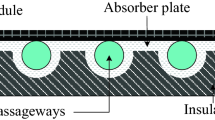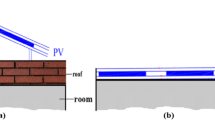Abstract
Buildings account for a significant amount of total energy consumption worldwide; and the use of fossil fuels in the short and long term will have serious and long-standing negative impacts on environment, including disruption to various ecosystems. Hence, it is vital to limit the growth of energy demand through energy efficiency in buildings. Double Skin Façade (DSF) technology is considered as one of the most advanced modes of direct passive systems for maximum use of solar energy to provide heat load and prevent heat loss in buildings. In general, the performance of DSF depends on climatic factors (such as solar radiation, air temperature, and wind speed) and various design parameters, including the effect of the gap between the outer and inner glass wall on the thermal behavior. Furthermore, the orientation of the building is one of the critical factors affecting the amount of energy consumed. Accordingly, the cooling rate, heating rate, and energy consumption at different angles are investigated by applying a numerical simulation. Due to the use of photovoltaics in the selected buildings, the amount of energy produced and consumed in different conditions has been inspected. Building energy modeling is also evaluated by rotating the building 90° at a time. The results show that more energy is produced in the south, west and east directions. The results show that the experimental design in this study saves 44% in energy consumption.



















Similar content being viewed by others
References
Fazelpour, F., Soltani, N., Markaria, E., Khezerloo, H.: Impact of multiple parameters on energy performance of PV-DSF buildings. Proceedings 2(23), 25–27 (2018)
Fazelpour, F., Markarian, E., Ziasistani, N.: DSF energy performance assessment considering different climatic regions of Iran and design parameters. In: IEEE International Conference on Environment and Electrical Engineering (2018)
Ghaffarianhoseini, A., Ghaffarianhoseini, A., Berardi, U., Tookey, J., Li, D.H.W., Kariminia, S.: Exploring the advantages and challenges of double-skin façades (DSFs). Renew. Sustain. Energy Rev. 60, 1052–1065 (2016)
Jiru, T.E., Taob, Y.-X., Haghighat, F.: Airflow and heat transfer in double skin facades. Energy Build. 43, 2760–2766 (2011)
Diarce, G., Campos-Celador, Á., Martin, K., Urresti, A., García-Romero, A., Sala, J.M.: A comparative study of the CFD modeling of a ventilated active façade including phase change materials. Appl. Energy 126, 307–317 (2014)
Gratia, E., De Herde, A.: Guidelines for improving natural daytime ventilation in an office building with a double-skin facade. Sol. Energy 81, 435–448 (2007)
Peng, J., Lu, L., Yang, H., Ma, T.: Comparative study of the thermal and power performances of a semi-transparent photovoltaic façade under different ventilation modes. Appl. Energy 138, 572–583 (2015)
Peng, J., Curcija, D.C., Selkowitz, S.E., Yang, H., Zhang, W.: Numerical investigation of the energy saving potential of a semi-transparent photovoltaic double-skin facade in a cool-summer Mediterranean climate. Appl. Energy 165, 345–356 (2016)
Luo, Y., Zhang, L., Wang, X., Xie, L., Liu, Z., Wu, J., Zhang, Y., He, X.: A comparative study on thermal performance evaluation of a new double skin façade system integrated with photovoltaic blinds. Appl. Energy 199, 281–293 (2017)
Li, D.H.W., Lam, T.N.T., Chan, W.W.H., Mak, A.H.L.: Energy and cost analysis of semi-transparent photovoltaic in office buildings. Appl. Energy 86, 722–729 (2009)
Peng, J., Lu, L., Yang, H.: An experimental study of the thermal performance of a novel photovoltaic double-skin facade in Hong Kong. Sol. Energy 97, 293–304 (2013)
Olivieri, L., Caamano-Martín, E., Martín-Chivelet, N.: Energy saving potential of semi-transparent photovoltaic elements for building integration. Energy 76, 572–583 (2014)
Zhanga, W., Lua, L., Penga, J., Song, A.: Comparison of the overall energy performance of semi-transparent photovoltaic windows and common energy-efficient windows in Hong Kong. Energy Build. 128, 511–518 (2016)
Han, J., Lu, L., Peng, J., Yang, H.: Performance of ventilated double-sided PV façade compared with conventional clear glass façade. Energy Build. 56, 204–209 (2013)
Barman, S., Chowdhury, A., Mathur, S., Mathur, J.: Assessment of the efficiency of window integrated CdTe based semi-transparent photovoltaic module. Sustain. Cities Soc. 37, 250–262 (2018)
Jayathissa, P., Luzzatto, M., Schmidli, J., Hofer, J., Nagy, Z., Schlueter, A.: Optimising building net energy demand with dynamic BIPV shading. Appl. Energy 202, 726–735 (2017)
Peng, J., Lu, L., Yang, H., Ma, T.: Validation of the Sandia model with indoor and outdoor measurements for semi-transparent amorphous silicon PV modules. Renew. Energy 80, 316–323 (2015)
Wang, M., Peng, J., Li, N., Yang, H., Wang, C., Li, X., Lu, T.: Comparison of energy performance between PV double skin facades and PV insulating glass units. Appl. Energy 194, 148–160 (2017)
Wang, M., Peng, J., Li, N., Lu, L., Ma, T., Yang, H.: Assessment of energy performance of semi-transparent PV insulating glass units using a validated simulation model. Energy 112, 538–548 (2016)
Skandalos, N., Karamanis, D.: Investigation of thermal performance of semi-transparent PV technologies. Energy Build. 124, 19–34 (2016)
Chen, F., Wittkopf, S.K., Ng, P.K., Du, H.: Solar heat gain coefficient measurement of semi-transparent photovoltaic modules with indoor calorimetric hot box and solar simulator. Energy Build. 53, 74–84 (2012)
Didoné, E.L., Wagner, A.: Semi-transparent PV windows: a study for office buildings in Brazil. Energy Build. 67, 136–142 (2013)
Qiu, C., Yang, H., Zhang, W.: Investigation on the energy performance of a novel semi-transparent BIPV system integrated with vacuum glazing. Build. Simul. 12, 29–39 (2019)
Hee, W.J., Alghoul, M.A., Bakhtyar, B., Elayeb, O.K., Shameri, M.A., Alrubaih, M.S., Sopian, K.: The role of window glazing on daylighting and energy saving in buildings. Renew. Sustain. Energy Rev. 42, 323–343 (2015)
Foustalieraki, M., Assimakopoulos, M.N., Santamouris, M., Pangalou, H.: Energy performance of a medium scale green roof system installed ona commercial building using numerical and experimental datarecorded during the cold period of the year. Energy Build. 135, 33–38 (2017)
Kapsis, K., Athienitis, A.K.: A study of the potential benefits of semi-transparent photovoltaics in commercial buildings. Sol. Energy 115, 120–132 (2015)
Do, S.L., Shin, M., Baltazar, J.-C., Kim, J.: Energy benefits from semi-transparent BIPV window and daylight-dimming systems for IECC code-compliance residential buildings in hot and humid climates. Sol. Energy 155, 291–303 (2017)
Han, J., Lu, L., Yang, H.: Numerical evaluation of the mixed convective heat transfer in a double-pane window integrated with see-through a-Si PV cells with low-e coatings. Appl. Energy 87, 3431–3437 (2010)
Luo, Y., Zhang, L., Liu, Z., Wu, J., Zhang, Y., Wu, Z.: Numerical evaluation on energy saving potential of a solar photovoltaic thermoelectric radiant wall system in cooling dominant climates. Energy 142, 384–399 (2018)
Scharf, B., Zluwa, I.: Case study investigation of the building physical properties of seven different green roof systems. Energy Build. 151, 564–573 (2017)
Movahhed, Y., Safari, A., Motamedi, S., Khoshkhoo, R.H.: Simultaneous use of PV system and green roof: a techno-economic study on power generation and energy consumption. Energy Procedia 159, 478–483 (2019)
Morakinyo, T.E., Kalani, K.W.D., Dahanayake, C., Ng, E., Chow, C.L.: Temperature and cooling demand reduction by green-roof types in different climates and urban densities: a co-simulation parametric study. Energy Build. 145, 226–237 (2017)
Monteiro, C.M., Calheiros, C.S.C., Martins, J.P., Costa, F.M., Palha, P., de Freitas, S., Ramos, N.M.M., Castro, P.M.L.: Substrate influence on aromatic plant growth in extensive green roofs in a Mediterranean climate. Urban Ecosyst. 20, 1347–1357 (2017)
Virk, G., Jansz, A., Mavrogianni, A., Mylona, A., Stocker, J., Davies, M.: Microclimatic effects of green and cool roofs in London and their impacts on energy use for a typical office building. Energy Build. 30, 214–228 (2015)
Miyazaki, T., Akisawa, A., Kashiwagi, T.: Energy savings of office buildings by the use of semi-transparent solar cells for windows. Renew. Energy 130, 281–304 (2005)
Karimi, M.S., Fazelpour, F., Rosen, M.A., Shams, M.: Comparative study of solar-powered underfloor heating system performance in distinctive climates. Renew. Energy 130, 524–535 (2019)
Ran, J., Tang, M.: Passive cooling of the green roofs combined with night-time ventilation and walls insulation in hot and humid regions. Sustain. Cities Soc. 38, 466–475 (2018)
Fazelpour, F., Vafaeipour, M., Rahbari, O., Valizadeh, M.H.: Assessment of solar radiation potential for different cities in Iran using a temperature-based method. In: Sustainability in Energy and Buildings, pp. 199–208 (2013)
Fazelpour, F., Roohi, E., Tajeddin, A.: Towards efficient implementation of solar plants: a priority analysis through multi-criteria decision approach. In: International Conference on Environment and Electrical Engineering, pp. 1–5 (2017)
Katal, F., Fazelpour*, F.: Multi-criteria evaluation and priority analysis of different types of existing power plants in Iran: an optimized energy planning system. Renew. Energy 120, 163–177 (2018)
Author information
Authors and Affiliations
Corresponding author
Additional information
Publisher's Note
Springer Nature remains neutral with regard to jurisdictional claims in published maps and institutional affiliations.
Rights and permissions
About this article
Cite this article
Fazelpour, F., Bakhshayesh, A., Alimohammadi, R. et al. An assessment of reducing energy consumption for optimizing building design in various climatic conditions. Int J Energy Environ Eng 13, 319–329 (2022). https://doi.org/10.1007/s40095-021-00461-6
Received:
Accepted:
Published:
Issue Date:
DOI: https://doi.org/10.1007/s40095-021-00461-6




